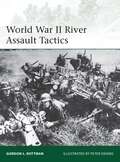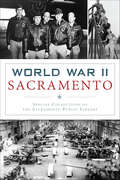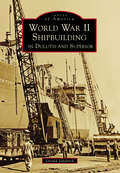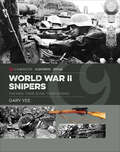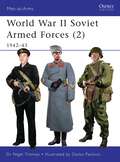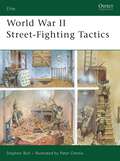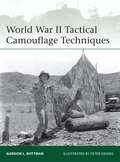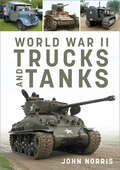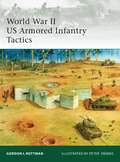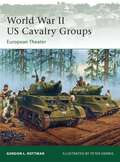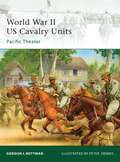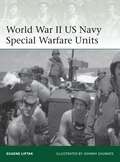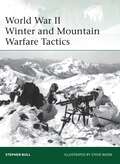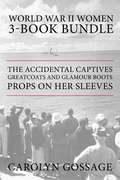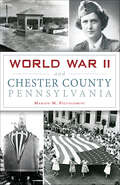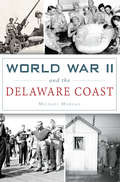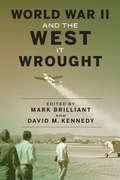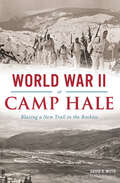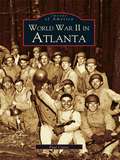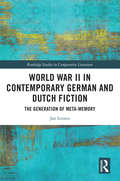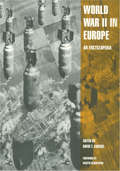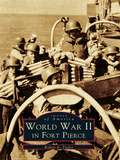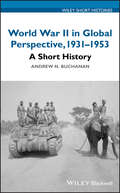- Table View
- List View
World War II River Assault Tactics
by Peter Dennis Gordon RottmanOn the major European and Russian fronts throughout World War II, the challenge of crossing rivers and other water obstacles under fire was absolutely central to any advance. The Panzers that crossed the Meuse at Sedan in May 1940 cut the French Army in two; the Wehrmacht's ability to cross the great rivers of the western USSR was vital to the lightning advances of Operation Barbarossa in 1941, and in 1943-45 the Red Army had to drive the Germans back from a succession of river lines during their advance to the Reich, culminating in the Vistula and Oder lines; in Italy the Rapido formed a bloody moat for the Cassino defences; and after D-Day the milestones on the Western Allies' advances were the Seine, the Somme, the Moselle, and finally the Rhine. The initial (hopefully surprise) assault could be made by infantry in light assault boats, and over rudimentary improvised bridges. But World War II armies depended on heavy mechanized equipment, and even if a bridgehead was seized, it then had to be held for long enough for engineers to bring up and erect prefabricated bridges strong enough to carry the tanks and artillery without which the bridgehead was doomed. Some of the most savage fighting of the war took place around bridgeheads, and the Allies invested considerable resources in the development of equipment and tactics for contested river crossings.This book explains the methods and the means, and analyzes specific successes and failures. It features a wealth of wartime photos, particularly from German sources, and full-color plates illustrate tactical scenarios that bring the subject alive.
World War II Sacramento (Military)
by Special Collections of the Sacramento Public LibrarySpurred into action by the attack on Pearl Harbor, Sacramento dragged itself out of the morass of the Great Depression and joined the war effort. Local citizens trained for Japanese attacks through Civilian Defense, cultivated thousands of acres of victory gardens and harnessed the agricultural riches of the region. Tens of thousands engaged in war work at local bases like the new McClellan Field, while Sacramento's diverse servicemen distinguished themselves in combat overseas. They would later return and transform the city into the modern Sacramento of today. Exclusive images and stories from the Special Collections of the Sacramento Public Library bring this story to life.
World War II Shipbuilding in Duluth and Superior (Images of America)
by Gerald SandvickWorld War II hinged on the Allies having enough ships to both fight the enemy and to carry millions of tons of war goods across the world’s oceans. Shipyards on the Atlantic, Gulf, and Pacific Coasts built thousands of vessels, but America’s sometimes forgotten Fourth Coast, the Great Lakes, built hundreds of ships as well. From 1940 to 1945, warships, cargo haulers, Coast Guard tenders, and fleet service auxiliaries of many types were launched from the two cities of Duluth, Minnesota, and Superior, Wisconsin, which lie at the far western end of Lake Superior. During the war, half a dozen shipyards in Duluth-Superior produced more than 200 vessels of 10 main types, up to 338 feet long and 5,000 tons, all having to make close to a 2,400-mile journey to the ocean. The shipyards grew from nearly nothing in 1939 to become industries employing thousands of men and women by 1945 and making a major contribution to the story of America in World War II.
World War II Snipers: The Men, Their Guns, Their Stories (Casemate Illustrated Special)
by Gary YeeThis illustrated military history reveals the untold story of WWII snipers, from training and firearms to combat and field operations.Though snipers played a significant role in the battlefields of World War II, they are often overlooked by historians. In this volume, military historian and firearms expert Gary Yee offers a comprehensive and fully illustrated narrative of snipers across the major theaters of conflict: Europe, the Eastern Front, and the Pacific. Drawing on memoirs, archives, wartime photographs, and eyewitness accounts, World War II Snipers presents a compelling and authoritative study.Each of the warring countries had its own unique methodology for selecting and training snipers. They recruited hunters, outdoorsmen, competitive shooters, and military veterans to take on this highly skilled role. They were deployed to ensure battlefield dominance and instill a paralyzing fear among the enemy. Yee tells the stories of these soldiers who were both admired and at times reviled by their own comrades. He also includes a lengthy chapter on the sniper rifles and other equipment issued to snipers.
World War II Soviet Armed Forces
by Nigel Thomas Darko PavlovicThis title presents a detailed analysis of the Soviet Army at the outbreak of World War II (1939-1945), including the Red Army's campaigns against Japan on the Manchurian plains as well as in Finland. It also covers the Red Army's first operations during Operation Barbarossa when the Red Army was forced to defend Mother Russia against the German onslaught. With a breakdown of all the armed forces including the army, air force, paratroopers, navy and NKVD troops, author Nigel Thomas gives special attention to the evolution of uniforms, equipment and insignia with the introduction of new regulations in 1935 and 1940.
World War II Street-Fighting Tactics
by Peter Dennis Stephen BullOsprey's study of street-fighting tactics during World War II (1939-1945). In a continuation of the tactics mini-series, this new book describes and analyzes the physical tactics of the close-quarter fighting that took place in the ruined cities on both the Western and Eastern Fronts of World War II. Street-to-street fighting in cities was not a new development, but the bombed-out shells of cities and advances in weaponry meant that World War II took it to a new level of savagery and violence. New tactics developed around the defenses that ruined cities offered. This book examines these tactics, describing how a small group of infantry could now destroy whole tank units for very little cost before melting away into the cities' rubble. It also analyzes the need for infantry units to clear ruins of the enemy, and looks at how this was done, and the cost of the slow house-to-house fighting that was seen across the war, from Stalingrad to Berlin. Packed with eye-witness accounts, tutorials from original training manuals, maps, and full color artwork which illustrates these tactics, this is an eye-opening insight into the tactics and experiences of infantry fighting their way through ruined cities in the face of heavy casualty rates and vicious resistance.
World War II Tactical Camouflage Techniques
by Peter Dennis Gordon RottmanThis book explains and illustrates the actual materials and techniques adopted (both successfully and unsuccessfully) by tactical units - i.e. the concealment of personnel, weapons, equipment, field positions, and movement by infantry riflemen and weapons crews, artillerymen, and vehicle crews. It covers all areas and seasons in the European and Mediterranean theaters of operations, for the US, British, German, and Soviet armies. It includes camouflage of the person, personal equipment, and weapons; natural materials and "expedient" techniques; issued camouflage materials such as nets, ponchos, etc; the principles of camouflaging equipment and vehicles, of positioning and terrain integration, the effects of light and shadow, and the use of decoy and dummy positions. Featuring meticulous full-color artwork and specially selected period photographs, this absorbing study casts new light on the camouflaging techniques developed by the major armies of World War II on a host of European battlefields.
World War II Trucks and Tanks
by John NorrisMany thousands of different types of vehicles were used by the armies during the Second World War for various roles, including the fighting vehicles such as armoured cars and tanks. Today these are very popular with enthusiasts who restore these historic vehicles to their pristine state and attend specialist gatherings around the UK, Europe and the USA.This book explores original and reconstructed military vehicles from British, US, Russian, Italian and German forces using stunning colour photographs. It also provides a detailed history of each vehicle’s development and use in the war, plus a wealth of technical information and rare internal shots. The range of vehicles includes trucks, ambulances, half-tracks, motorcycles, bulldozers, armoured cars and of course the impressive range of tanks, from tankettes to the fearsome German Tiger. Some vehicles are so rare that examples have been recreated using designs of the era and together with the original vehicles their fascinating wartime experiences are revealed. From the Moto Guzzi tricycle to the Schwimmwagen, the T-34 to the Austin ambulance, this is the perfect book for recreating, restoring and exploring the history of these classic military vehicles.
World War II US Armored Infantry Tactics
by Peter Dennis Gordon RottmanOsprey's study of America's armored infantry tactics in World War II (1939-1945). Little has been published on US armored infantry units and tactics over the years despite their key role in World War II. There were a total of 57 armored infantry battalions and two regiments that served throughout the war and in all theaters. Equipped with halftracks, they fought as part of combined arms teams and combat commands alongside tanks, tank destroyers and artillery battalions. Significantly, they were not simply standard infantry battalions provided with halftracks. Their company and platoon organization was very different from the standard infantry unit and these highly mobile, heavily armed battalions fought in an entirely different manner. Using period training manuals and combat reports this book provides an exclusive look at the unique tactics developed by US armored infantry units including movement formations and battle drills.From the Trade Paperback edition.
World War II US Cavalry Groups: European Theater
by Peter Dennis Gordon RottmanThe cavalry regiments of the US Army were in the process of being transformed into a mechanized force when the USA entered World War II. While those cavalry regiments deployed to the Pacific to fight the Japanese were turned into infantry units, those sent to Europe were employed as light armor in the cavalry's traditional spearhead roles - reconnaissance, the screening of advances and flanks, and the pursuit of beaten enemy forces. Equipped with M8 Greyhound armored cars, M5 Stuart and M24 Chaffee light tanks, and halftracks, these units were designated cavalry groups (mechanized), each c. 1,700 strong and divided into two heavily armed squadrons. They were seldom attached to divisions, but to higher-level corps commands, meaning they could be shifted around quickly and independently and be formed at need into flexible battle groups with armored, infantry, and other units, depending on the mission. Featuring specially drawn full-color illustrations depicting uniforms, insignia, armored vehicles, and tactical scenarios, this is the story of the US cavalry units that led the advance to victory in Europe during World War II.
World War II US Cavalry Units: Pacific Theater
by Peter Dennis Gordon RottmanOsprey's elite series title for all cavalry units that participated in World War II (1939-1945). At the time of Pearl Harbor, the United States Army still had ten cavalry regiments that were mounted on horses. One, the 26th (Filipino Scouts) fought on horseback in the Philippines, while the rest were dismounted and fought as infantry. Despite this, the cavalry units maintained their own unique organization, traditions, and identity as they saw action in the Pacific and China-Burma-India theatre. This book covers all of the US cavalry units to see action during World War II, most of which survive to this day. It includes the little-covered Texan National Guard regiments, who took part in the vicious street fighting in Manila in 1945, and who fought beside ex-Merrill's Marauders as a deep penetration unit. It also contains detailed color-plates showing the unique uniforms of the US Army's last mounted cavalry as well as tropical combat dress worn by the dismounted units.From the Trade Paperback edition.
World War II US Navy Special Warfare Units
by Johnny Shumate Eugene LiptakWhen the United States entered World War II, it was apparent that the war would only be won by taking the fight to the Axis, in the shape of large-scale amphibious landings. Accordingly, the US Navy developed several types of specialized unit to reconnoiter potential landing areas, degrade the enemy's ability to resist, and assist the landing forces on to the beaches. These operatives had to get there first, alone, and carry out their missions before the GIs and Marines could land with any chance of success.Formed in September 1942 and active in the Mediterranean, European, and Pacific theaters, the Scouts and Raiders were forerunners of the SEALs; they used canoes to secretly reconnoiter beaches before combat landings, and placed marker beacons. In the Mediterranean and the Philippines, the Beach Jumpers made elaborate simulated landings to fool the enemy as to real locations, including radar and sound deception.Active in the Mediterranean, Normandy, and the South West Pacific, the Naval Combat Demolition Units cleared beach obstacles in advance of combat landings, and guided landing craft to their destination, while the Underwater Demolition Teams carried out similar tasks in the Pacific theater only. In co-operation (and sometimes competition) with the Office of Strategic Services, Naval Group China gathered intelligence in that theater, and trained and fought with Chinese guerrillas behind Japanese lines.All these special warfare units played vital roles in the prosecution of the Allied war effort across the globe. Their distinctive uniforms, insignia, special clothing, equipment, and weaponry are illustrated and described in this engaging study.
World War II Winter and Mountain Warfare Tactics
by Steve Noon Stephen BullAlthough prolonged warfare in subzero temperatures and/or at high altitude had occurred from time to time before 1900, the twentieth century saw an unprecedented emphasis on fighting in all terrains, seasons and weather conditions. Such conditions made even basic survival difficult as subzero temperatures caused weapons to jam, engines to seize up and soldiers to suffer frostbite, snow blindness and hypothermia; even the hardiest, best-equipped troops found defending their positions very difficult, let alone conducting offensive operations. The conditions often favoured small groups of mobile, lightly armed soldiers, rather than the armoured forces or air power that dominated other combat environments.Some European armies developed small numbers of specialist alpine troops before and during World War I, but these proved to be insufficient as nearly all the major combatants of World War II found themselves fighting for extended periods in extremely hostile cold-weather and/or alpine environments. Some, like the German forces invading the USSR in 1941, were - apart from a few specialist formations - poorly equipped and trained for the unique difficulties imposed by such conditions, and were initially forced to improvise. Others, such as the Finns in the Winter War of 1939-40, outclassed their Soviet opponents with their mobility (many soldiers were already competent skiers at the outbreak of war), marksmanship, bold initiative and decisive leadership.Drawing upon manuals, memoirs and unit histories and illustrated with period tactical diagrams and specially commissioned full-colour artwork, this study sheds new light on the winter-warfare tactics and techniques of the US, British, German, Soviet and Finnish armies of World War II.
World War II Women 3-Book Bundle: The Accidental Captives / Greatcoats and Glamour Boots / Props on Her Sleeves
by Carolyn Gossage Mary Hawkins BuchBravery, patriotism, and sacrifice marked the women caught up in conflict during the Second World War. This special collection of three books tells the stories of a young airwoman, prisoners of war, and women in service. Includes: The Accidental Captives: The Story of Seven Women Along in Nazi Germany In April 1941, a passenger ship sailing from New York to Cape Town was attacked and sunk by a German raider. The passengers were pulled from the water and transported to Nazi-occupied France, where the majority were released. Among those left behind were seven Canadian women. This is the tale of the year they spent together in Germany. Greatcoats and Glamour Boots: Canadian Women at War, 1939-1945 The colourful story of Canada’s forgotten women who volunteered for service during the Second World War. Props on Her Sleeves: The Wartime Letters of a Canadian Airwoman A first-hand account of the experiences of a young Canadian airwoman who served both in Canada and on overseas duty, this series of 150 letters brings home the day-to-day immediacy of life in uniform during the Second World War.
World War II and Chester County, Pennsylvania (Military)
by Marion M. PiccolominiRegiments from Chester County fought bravely in all theaters of World War II, while locals at home took extraordinary measures to support the Allies. West Chester resident G. Raymond Rettew developed a process to mass produce vitally needed penicillin while a peaceful farm transformed into the bustling Valley Forge General Hospital in 1943. Women entered labor positions at companies, including Lukens Steel, to meet production demands. The Coatesville YMCA created and distributed a newsletter to soldiers so the boys on the front had the news from back home. Author Marion Piccolomini celebrates the resilience and perseverance of Chester County residents in the midst of total war.
World War II and Mexican American Civil Rights
by Richard Griswold Del CastilloWorld War II marked a turning point for Mexican Americans that fundamentally changed their expectations about how they should be treated by the greater U. S. society. The experiences of fighting alongside white Americans in the military, as well as of working in factory jobs for wages equal to those of Anglo workers, made Mexican Americans less willing to tolerate the second-class citizenship that had been their lot before the war. Having proven their loyalty and "Americanness" during World War II, Mexican Americans in the postwar years wanted to have the civil rights they knew they had earned. In this book, Richard Griswold del Castillo and Richard Steele investigate how the World War II experiences of Mexican Americans galvanized their struggle for civil rights and how the U. S. government responded to the needs and aspirations of Mexican Americans. The authors demonstrate, for example, that the U. S. government "discovered" Mexican Americans during World War II and set about addressing some of their problems as a way of forestalling a sense of grievance and disaffection that might have made the Mexican American community unwilling to support the war effort. The authors also show that, as much or more than governmental programs, the personal wartime experiences of Mexican Americans formed their civil rights consciousness. The book concludes with a selection of key essays and historical documents from the World War II period that collectively gives a first-person understanding of the civil rights struggles of Mexican Americans.
World War II and the Delaware Coast (Military)
by Michael MorganWithin weeks of Pearl Harbor, German U-boats arrived off the Delaware coast and attacked numerous ships along the vital shipping lanes to Philadelphia and Wilmington. On February 28, 1942, two German torpedoes hit the destroyer Jacob Jones, which was carrying more than one hundred American sailors. It sank in less than an hour. A center for military activity, Lewes became a refuge for many survivors from such attacks. The dunes along Cape Henlopen hid the massive artillery batteries of Fort Miles. Residents of the beachfront communities rallied amid the blackout regulations and air raid drills with rationing and scrap drives. Spotters watched for enemy warships in concrete towers that still line the coast. Author Michael Morgan tells the remarkable story of a coast at war.
World War II and the West It Wrought
by David M. Kennedy Mark BrilliantFew episodes in American history were more transformative than World War II, and in no region did it bring greater change than in the West. Having lifted the United States out of the Great Depression, World War II set in motion a massive westward population movement, ignited a quarter-century boom that redefined the West as the nation's most economically dynamic region, and triggered unprecedented public investment in manufacturing, education, scientific research, and infrastructure—an economic revolution that would lay the groundwork for prodigiously innovative high-tech centers in Silicon Valley, the Puget Sound area, and elsewhere. Amidst robust economic growth and widely shared prosperity in the post-war decades, Westerners made significant strides toward greater racial and gender equality, even as they struggled to manage the environmental consequences of their region's surging vitality. At the same time, wartime policies that facilitated the federal withdrawal of Western public lands and the occupation of Pacific islands for military use continued an ongoing project of U.S. expansionism at home and abroad. This volume explores the lasting consequences of a pivotal chapter in U.S. history, and offers new categories for understanding the post-war West. Contributors to this volume include Mark Brilliant, Geraldo L. Cadava, Matthew Dallek, Mary L. Dudziak, Jared Farmer, David M. Kennedy, Daniel J. Kevles, Rebecca Jo Plant, Gavin Wright, and Richard White.
World War II at Camp Hale: Blazing a New Trail in the Rockies (Military Ser.)
by David R WitteIn April 1942, a little over two years before the Tenth Mountain Division officially obtained its name, the U.S. Army began the unprecedented construction of a training facility for its newly acquired ski and mountain troops. Located near Pando in Colorado's Sawatch Range, the site eventually known as Camp Hale sits at an elevation of 9,250 feet. Immense challenges in its creation and subsequent training included ongoing racial conflict, the high altitude and blustery winters. However, thanks to contributions from civilian workers and the Women's Army Corps and support from neighboring communities, the camp trained soldiers who helped defeat the Axis powers in World War II. Veteran David R. Witte brings to life this enduring story.
World War II for Kids: A History with 21 Activities (For Kids series)
by Senator John Mccain Richard PanchykNow more than ever, kids want to know about our country's great struggles during World War II. This book is packed with information that kids will find fascinating, from Hitler's rise to power in 1933 to the surrender of the Japanese in 1945. Much more than an ordinary history book, it is filled with excerpts from actual wartime letters written to and by American and German troops, personal anecdotes from people who lived through the war in the United States, Germany, Britain, Russia, Hungary, and Japan, and gripping stories from Holocaust survivors--all add a humanizing global perspective to the war. This collection of 21 activities shows kids how it felt to live through this monumental period in history. They will play a rationing game or try the butter extender recipe to understand the everyday sacrifices made by wartime families. They will try their hands at military strategy in coastal defense, break a code, and play a latitude and longitude tracking game. Whether growing a victory garden or staging an adventure radio program, kids will appreciate the hardships and joys experienced on the home front.
World War II in Atlanta (Images of America)
by Paul CraterFew historical events shaped the city of Atlanta more than World War II. A hub for the Civil Rights movement in the 1950s and 1960s, Atlanta is now home to over four million people and serves as national headquarters for a dozen Fortune 500 companies. It would never have developed to such prominence, however, without the Allied victory in the global conflict. From the social reforms of the New Deal to the economic impact of war industries, to the early gains of the Civil Rights movement, World War II in Atlanta illustrates the transformation of the city from a regional Southern town into a major industrial metropolis. Through images selected from the collections of the Kenan Research Center at the Atlanta History Center, this volume examines the war's role in creating today's vibrant, sprawling megalopolis with its diverse population. View photographs of wartime president Franklin D. Roosevelt during his visits to Atlanta and other Georgia cities. Pictures from the homefront include war bond advertisements, Bob Hope at a USO show, and victory garden promotions. The two warships named Atlanta as well as the Liberty ships named for famous Atlantans illustrate the symbolic connections between the city and the war. In addition, portraits and personal stories of some of Atlanta's sons and daughters who served in the war highlight the human side of the conflict.
World War II in Contemporary German and Dutch Fiction: The Generation of Meta-Memory (Routledge Studies in Comparative Literature)
by Jan LensenWorld War II in Contemporary German and Dutch Fiction: The Generation of Meta-Memory offers a comparative study of the construction of World War II memory in contemporary German, Flemish, and Dutch literature. More specifically, it investigates in what ways the large temporal distance to the historical events has impacted how literary writers from these three literatures have negotiated its meaning and form during the last decades. To that end, this book offers analyses of nine novels that demonstrate a pronounced reflexivity on the conditions of contemporary remembering. Rather than a dig for historical truth or a struggle with historical trauma, these novels reflect on the transmission, the narrative shapes, the formation processes, and the functions of World War II memory today, while asserting a self-conscious and often irreverent approach toward established mnemonic routines, practices, and rules. As the analyses show, this approach is equally articulated through the novels’ poetics, which are marked by a large formal diversity and a playfulness that highlights mnemonic agency, a posttraumatic positioning, and the ascendency of the literary over the historiographical. Based on these findings, this book proposes the emergence of a new paradigm within the postwar cultural assessment of World War II: the generation of meta-memory.
World War II in Europe: An Encyclopedia (Military History of the United States)
by David T. Zabecki Carl O. Schuster Paul J. Rose William H. Van HusenFirst Published in 1999. Routledge is an imprint of Taylor & Francis, an informa company.
World War II in Fort Pierce (Images of America)
by Robert A. TaylorFew Florida communities felt the impact of World War II as much as the Atlantic-coast town of Fort Pierce. With a population that soared along with its economy, the small city made an important contribution to Allied victory by hosting a major military training base. Prior to that, the war had come only as close as the German submarines stalking targets off the southern coast of the peninsula. In 1943, however, the U.S. Navy commissioned its newestamphibious training base in Fort Pierce, and tens of thousands of young men would eventually prepare for combat on the town's sunny shores. The intensive physical and mental training was hardly "a day at the beach," and within a few months, Fort Pierce had become a major military post with a national reputation. It also became the training site of some of the most elite units of the armed forces, including the Scouts and Raiders, U.S. Army Rangers, and the legendary "frogmen."
World War II in Global Perspective, 1931-1953: A Short History (Wiley Short Histories)
by Andrew N. BuchananA comprehensive review of World War II that offers a global-level analysis Written for academics and students of history, World War II in Global Perspective, 1931-1953 presents a dynamic and global account of the historical events prior to, during, and after World War II. The author—a noted expert on the topic—explores the main theaters of the war and discusses the connections between them. He also examines the impact of the war on areas of the world that are often neglected in historical accounts, including Latin America, sub-Saharan Africa, and the so-called ‘neutral’ countries. This comprehensive text clearly shows how in the struggle against the Axis powers, the United States replaced Britain as the global superpower. The author discusses the Japanese invasion of Manchuria in 1931 and the Korean War (1950-1953) and argues that the core years of the war (1939-1945) cannot be understood without considering the turbulent events that framed them. The text puts World War II in context as a series of large regional conflicts that intersected and overlapped, finally emerging as a genuine “world war” with the formal entry of the United States in late 1941. This vital text: Offers a comprehensive review of World War II that frames it in a global context Gives weight to the economic and political developments of the war Provides a robust account of the main military campaigns Contains illustrations and maps that themselves highlight little-known aspects of the global war
